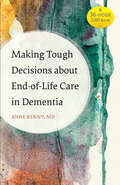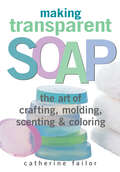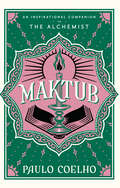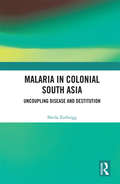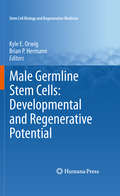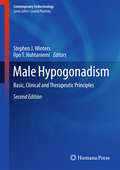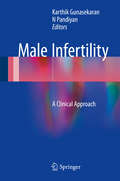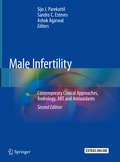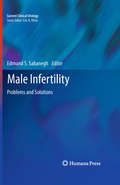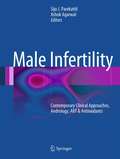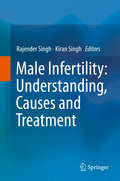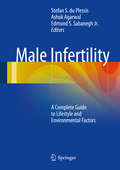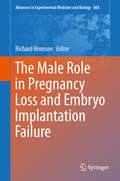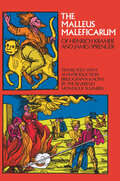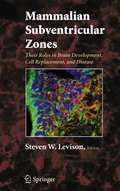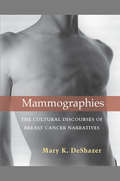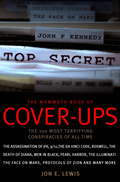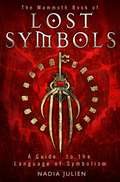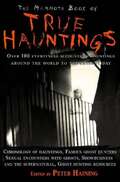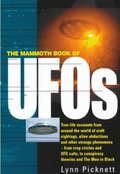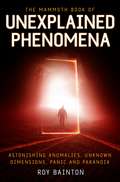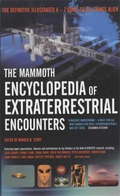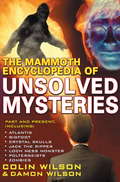- Table View
- List View
Making Tough Decisions about End-of-Life Care in Dementia: (a 36-hour Day Book) (A 36-Hour Day Book)
by Anne KennyEach year, more than 500,000 people are diagnosed with dementia in the United States. As stunning as that figure is, countless family members and caregivers are also affected by each diagnosis. Families are faced with the need to make vital end-of-life decisions about medical treatment, legal and financial matters, and living situations for those who no longer can; no one is prepared for this process. And many caregivers grapple with sadness, confusion, guilt, anger, and physical and mental exhaustion as dementia enters its final stage. In Making Tough Decisions about End-of-Life Care in Dementia, Dr. Anne Kenny, a skilled palliative care physician, describes how to navigate the difficult journey of late-stage dementia with sensitivity, compassion, and common sense. Combining her personal experience caring for a mother with dementia with her medical expertise in both dementia and end-of-life care, Dr. Kenny helps the reader prepare for a family member's death while managing their own emotional health.Drawing on stories of families that Dr. Kenny has worked with to illustrate common issues, concerns, and situations that occurs in late-stage dementia, this book includes practical advice about;€¢ making life-altering decisions while preparing for a loved one's inevitable death;€¢ medical care, pain, insomnia, medication, and eating ;€¢ caring for the caregiver;€¢ having conversations about difficult topics with other family members and with health care, legal, and financial professionalsConcrete to-do lists and lists of important points provide information at a glance for busy caregivers. Each chapter concludes with a list of additional resources for more information and help. Making Tough Decisions about End-of-Life Care in Dementia is a lifeline, an invaluable guide to assist in the late stage of dementia.
Making Transparent Soap: The Art Of Crafting, Molding, Scenting & Coloring
by Catherine FailorWith basic ingredients and standard kitchen tools you can craft your own transparent soaps that are milder, richer, and creamier than any commercial product. Eschewing complex methods and expensive equipment, Catherine Failor uses a simple, dependable process that makes beautiful transparent soaps every time. Failor&’s easy-to-follow photographic instructions are accompanied by proven recipes and plenty of suggestions for colorful and sweet-smelling variations. You&’ll soon be creating your own signature soap blends that deliver refreshing scents and are gentle enough for even the most sensitive skin.
Malaria in Colonial South Asia: Uncoupling Disease and Destitution
by Sheila ZurbriggThis book highlights the role of acute hunger in malaria lethality in colonial South Asia and investigates how this understanding came to be lost in modern medical, epidemic, and historiographic thought. Using the case studies of colonial Punjab, Sri Lanka, and Bengal, it traces the loss of fundamental concepts and language of hunger in the inter-war period with the reductive application of the new specialisms of nutritional science and immunology, and a parallel loss of the distinction between infection (transmission) and morbid disease. The study locates the final demise of the ‘Human Factor’ (hunger) in malaria history within pre- and early post-WW2 international health institutions – the International Health Division of the Rockefeller Foundation and the nascent WHO’s Expert Committee on Malaria. It examines the implications of this epistemic shift for interpreting South Asian health history, and reclaims a broader understanding of common endemic infection (endemiology) as a prime driver, in the context of subsistence precarity, of epidemic mortality history and demographic change. This book will be useful to scholars and researchers of public health, social medicine and social epidemiology, imperial history, epidemic and demographic history, history of medicine, medical sociology, and sociology.
Malaria in Colonial South Asia: Uncoupling Disease and Destitution
by Sheila ZurbriggThis book highlights the role of acute hunger in malaria lethality in colonial South Asia and investigates how this understanding came to be lost in modern medical, epidemic, and historiographic thought. Using the case studies of colonial Punjab, Sri Lanka, and Bengal, it traces the loss of fundamental concepts and language of hunger in the inter-war period with the reductive application of the new specialisms of nutritional science and immunology, and a parallel loss of the distinction between infection (transmission) and morbid disease. The study locates the final demise of the ‘Human Factor’ (hunger) in malaria history within pre- and early post-WW2 international health institutions – the International Health Division of the Rockefeller Foundation and the nascent WHO’s Expert Committee on Malaria. It examines the implications of this epistemic shift for interpreting South Asian health history, and reclaims a broader understanding of common endemic infection (endemiology) as a prime driver, in the context of subsistence precarity, of epidemic mortality history and demographic change. This book will be useful to scholars and researchers of public health, social medicine and social epidemiology, imperial history, epidemic and demographic history, history of medicine, medical sociology, and sociology.
Male Germline Stem Cells: Developmental and Regenerative Potential (Stem Cell Biology and Regenerative Medicine)
by Kyle E. E. Orwig and Brian P. P. HermannScientists investigating germ cells have, over the past 15 years, originated discoveries and innovations that give us valuable insights into the mechanisms that regulate not just stem cell function, but human development in its widest sense. With contributions from some of the leading researchers in the field, Male Germline Stem Cells: Developmental and Regenerative Potential assesses the implications of these discoveries for understanding the fundamental biology of germline stem cells as well as their potential for human stem cell-based therapies. This monograph covers many of the fundamental issues now being explored by today’s generation of stem cell researchers, including the field’s potential for regenerative medicine. Ranging from an assessment of the pluripotency of primordial germ cells and their possible applications in treating testicular cancer, to the recovery of once-mordant fertilization-competent sperm, this volume has it all. It is a reference point for any scientist involved in related research as well as being a timely summation of what could prove to be a hugely exciting and very fruitful area of inquiry.
Male Hypogonadism: Basic, Clinical and Therapeutic Principles (Contemporary Endocrinology)
by Stephen J. Winters Ilpo T. HuhtaniemiNow in a revised second edition, this comprehensive text covers all aspects of male hypogonadism from the basic science to clinical management, comprehensively explaining and applying new insights to the treatment of hypogonadal men. Chapters covering neuroendocrine control of testicular function, Leydig cell function, spermatogenesis, and normal and delayed puberty open the book. The focus then turns to the pathophysiology and treatment of hypogonadism and other forms of testicular dysfunction, such as Klinefelter syndrome, cryptorchidism, and disorders of the pituitary, as well as reproductive and endocrine consequences of cancer treatment, environmental factors, obesity and aging. Next are chapters that describe the available options for androgen replacement therapy, and the outcomes when men with hypogonadism of various causes are treated with testosterone, as well as a chapter devoted to current approaches to stimulating spermatogenesis in gonadotropin-deficient men. Highly practical and updated with the latest available data, this second edition of Male Hypogonadism: Basic, Clinical and Therapeutic Principles cogently presents a large body of scientific information on male reproductive endocrinology to provide a thorough understanding of the pathophysiology, clinical characteristics, and treatments for disorders that adversely affect testicular function.
Male Infertility: A Clinical Approach
by Karthik Gunasekaran N PandiyanThe book aims to bring into focus the current understanding of male reproduction and the pathological basis of failure to reproduce in men. Infertility in men is a common disorder. However, attempts at scientific study of male infertility are of very recent origin. Many questions about the physiology and pathophysiology of male reproduction are still not clear. The chapters are written by authorities in the field with great clinical experience. The primary focus would be on clinical perspective; however emphasis would also be placed on basic research and molecular biology.
Male Infertility: Contemporary Clinical Approaches, Andrology, ART and Antioxidants (Springerbriefs In Reproductive Biology Ser.)
by Sijo J. Parekattil Sandro C. Esteves Ashok AgarwalA groundbreaking contribution to the literature now in its revised and expanded second edition, this textbook offers a comprehensive review of diagnostic and treatment techniques for male infertility. This state-of-the-art, evidence-based textbook incorporates new multidisciplinary and complementary medicine approaches to create a first-of-its-kind guide to treatment strategies for male infertility and beyond. While this new edition is primarily designed as a reference for students and residents in reproductive medicine and andrology, it will be equally useful as well for professionals in urology, reproductive endocrinology, embryology, and research fields who are interested in the role that antioxidants play in male infertility.World-renowned experts in these areas have been selected to participate in this work. Careful selection of the highest quality content will span the whole range of topics in the area of male infertility, providing a complete review of well-established and current diagnostic and treatment techniques for male infertility. The incorporation of 20 new chapters will enhance the book’s appeal by including the most recent advances brought to the male infertility arena. Additionally, this edition incorporates new features, including bulleted key points, review criteria and select video clips demonstrating some of the most fascinating male infertility treatment modalities. A dedicated new section on current guidelines on male infertility will enlighten readers on how to most optimally manage male infertility clinical scenarios. Covering all aspects of diagnosis and management, ART, lifestyle factors and associated conditions for male infertility, Male Infertility: Contemporary Clinical Approaches, Andrology, ART and Antioxidants will be a readily accessible, high quality reference for medical students and residents, and will be of significant value to professionals working in the various fields treating this condition as well.
Male Infertility: Problems and Solutions (Current Clinical Urology)
by Edmund S. SabaneghMale Infertility: Problems and Solutions provides a summary of state of the art developments in male infertility for both new and experienced practitioners. Written in a clear, concise and readable style, this volume allows the reader to obtain rapid answers to this challenging medical issue. Special emphasis is placed on diagnostic and treatment algorithms. Topics covered include interpretation of semen analysis and advanced testing, endocrine and genetic evaluation, diagnosis of azoospermia as well as an up-to-date interpretation and analysis of the many new therapies available for the treatment of male factor infertility. Male Infertility: Problems and Solutions provides rapid acquisition of pertinent background and development of management plans through the use of concise discussion and treatment algorithms and thus will be of great value to general urologists, gynecologists, primary care providers and allied health providers who manage infertility in both men as well as women.
Male Infertility: Contemporary Clinical Approaches, Andrology, ART & Antioxidants
by Sijo J. Parekattil and Ashok AgarwalA ground-breaking contribution to the literature, Male Infertility: Contemporary Clinical Approaches, Andrology, ART & Antioxidants offers a comprehensive review of well-established, current diagnostic and treatment techniques for male infertility. This state-of-the-art, evidence-based resource incorporates new multidisciplinary and complementary medicine approaches to create a first-of-its-kind guide to treatment strategies involving antioxidants for male infertility. Designed as an easily accessible practical reference for daily use, Male Infertility: Contemporary Clinical Approaches, Andrology, ART & Antioxidants provides a high quality guide for urologists, reproductive endocrinologists, embryologists, andrologists, biologists and research scientists interested in the role that antioxidants play in male infertility.
Male Infertility: Understanding, Causes and Treatment
by Rajender Singh Kiran SinghThis book covers the latest research on male infertility. The topics discussed range from understanding the genetic basis of infertility, to its causes and treatment. Since infertility is also of great interest to the general public, the book also includes a detailed description of what infertility is and how one can understand the different types. Given the complex etiology of infertility, the book includes a number of chapters defining the known and probable causes of male infertility. Providing detailed information suitable for patients and clinicians alike, it also features a separate section on treatment, the ultimate goal.
Male Infertility: A Complete Guide to Lifestyle and Environmental Factors (Current Clinical Urology Ser.)
by Stefan S. du Plessis Ashok Agarwal Edmund S. Sabanegh Jr.This unique text provides a comprehensive yet concise review of the various environmental factors and lifestyle choices which impact male fertility, with special emphasis on the mechanisms that contribute to decreased sperm production and impaired function. Internationally recognized scientists and clinicians, leaders in the field of infertility, gather their insights and discuss how to prevent, address and cure male infertility caused by factors such as smoking, alcohol consumption, medication and drug use, obesity, dietary and exercise habits, sexually transmitted infections, psychological stress and occupational exposure to chemicals and radiation. Written in an easy to follow, informal yet scientific style, Male Infertility offers invaluable clinical guidelines for physicians and infertility experts and new data and research of great interest to basic scientists, andrologists and embryologists.
The Male Role in Pregnancy Loss and Embryo Implantation Failure (Advances in Experimental Medicine and Biology #868)
by Richard BronsonNovel topics compiled in this one-of-a-kind volume provide tantalizing hints for clinical application through future translational research. Only recently have we come to ask what role the male might play in pregnancy loss and embryo implantation failure, beyond contributing an abnormal set of paternal chromosomes at fertilization. This volume explores the recent evidence that these conditions might also be related to the transmission of previously unrecognized chromosomal micro-deletions and duplications, or via the epigenetic dysregulation of early embryonic gene function by spermatozoal microRNAs or alterations in sperm DNA methylation patterning, or by DNA damage secondary to either reactive oxygen species or environmental toxicants. In addition, the composition of seminal plasma has been found to be highly complex, containing many factors that play important roles in altering the uterine environment and the female immune system permissive of embryo implantation and trophectoderm outgrowth leading to successful pregnancy. Coverage includes an examination of both spermatozoa and seminal fluid component factors.
The Malleus Maleficarum of Heinrich Kramer and James Sprenger (Dover Occult)
by Montague SummersFor nearly three centuries Malleus Maleficarum (The Witches' Hammer) was the professional manual for witch hunters. This work by two of the most famous Inquisitors of the age is still a document of the forces of that era's beliefs. Under a Bull of Pope Innocent VIII, Kramer and Sprenger exposed the heresy of those who did not believe in witches and set forth the proper order of the world with devils, witches, and the will of God. Even if you do not believe in witchcraft, the world of 1484 did.Contemporary cases illustrate methods by which witches attempt to control and subvert the world: How and why women roast their first-born male child; the confession of how to raise a tempest by a washwoman suspended "hardly clear of the ground" by her thumbs; methods of making a formal pact with the Devil; how witches deprive men of their vital member; and many others. Methods of destroying and curing witchcraft, such as remedies against incubus and succubus devils, are exemplified and weighed by the authors.Formal rules for initiating a process of justice are set down: how it should be conducted and the method of pronouncing sentence; when to use the trial by the red-hot-iron; how the prosecutor should protect himself; how the body is to be shaved and searched for tokens and amulets, including those sewn under the skin. As Summers says, it was the casebook on every magistrate's desk.Montague Summers has given a very sympathetic translation. His two introductions are filled with examples of witchcraft and the historical importance of Malleus Maleficarum. This famous document should interest the historian, the student of witchcraft and the occult, and the psychologist who is interested in the medieval mind as it was confronted with various forces which could be explained only by witchcraft.
Mammalian Subventricular Zones: Their Roles in Brain Development, Cell Replacement, and Disease
by Steve LevisonThis text provides a comprehensive summary of research and findings that have lead to the current understanding of the subventricular zones. It provides an overview of the roles of subventricular zones in normal development and in disease and a foundation from which current and future studies can be evaluated.
Mammographies: The Cultural Discourses of Breast Cancer Narratives
by Mary K. DeShazerWhile breast cancer continues to affect the lives of millions, contemporary writers and artists have responded to the ravages of the disease in creative expression. Mary K. DeShazer’s book looks specifically at breast cancer memoirs and photographic narratives, a category she refers to as mammographies, signifying both the imaging technology by which most Western women discover they have this disease and the documentary imperatives that drive their written and visual accounts of it. Mammographies argues that breast cancer narratives of the past ten years differ from their predecessors in their bold address of previously neglected topics such as the link between cancer and environmental carcinogens, the ethics and efficacy of genetic testing and prophylactic mastectomy, and the shifting politics of prosthesis and reconstruction. Mammographies is distinctive among studies of contemporary illness narratives in its exclusive focus on breast cancer, its analysis of both memoirs and photographic texts, its attention to hybrid and collaborative narratives, and its emphasis on ecological, genetic, transnational, queer, and anti-pink discourses. DeShazer’s methodology—best characterized as literary critical, feminist, and interdisciplinary—includes detailed interpretation of the narrative strategies, thematic contours, and visual imagery of a wide range of contemporary breast cancer memoirs and photographic anthologies. The author explores the ways in which the narratives constitute a distinctive testimonial and memorial tradition, a claim supported by close readings and theoretical analysis that demonstrates how these narratives question hegemonic cultural discourses, empower reader-viewers as empathic witnesses, and provide communal sites for mourning, resisting, and remembering.
The Mammoth Book of Cover-Ups: The 100 Most Terrifying Conspiracies Of All Time (Mammoth Books)
by Jon E. LewisThe Assassination of JFK, 9/11, the Da Vinci Code, The Death of Diana, Men in Black, Pearl Harbor, The Illuminati, Protocols of Zion,Hess, The Bilderberg Group, New World Order, ElvisFluoridization, Martin Luther King's murder, Opus Dei, The Gemstone Files, John Paul I, Dead Sea Scrolls, Lockerbie bombing, Black helicopters... In other words everything 'they' never wanted you to know and were afraid you might ask! Jon E. Lewis explores the 100 most terrifying cover-ups of all time, from the invention of Jesus' divinity (pace the Da Vinci Code) to Bush's and Blair's real agenda in invading Iraq. Entertainingly written and closely documented, the book provides each cover-up with a plausibility rating.Uncover why the Titanic sank, ponder the sinister Vatican/Mafia network that plotted the assassination of liberal John Paul, find out why NASA 'lost' its files on Mars, read why no-one enters Area 51, and consider why medical supplies were already on site at Edgware Road before the 7/7 bombs detonated. Just because you are paranoid, it doesn't mean that they aren't out to conspire against you.
The Mammoth Book of Lost Symbols: A Dictionary of the Hidden Language of Symbolism (Mammoth Books)
by Nadia JulienHumanity has always used symbols-material objects used to denote difficult, abstract concepts-to describe thoughts and feelings, or to protect secret truths from common knowledge. This concise A-Z guide is a fascinating work of reference that brings to light all the symbols and symbolisms of the world, many aspects of which have been lost to time, including Freemasonry, the Kabbalah, the tarot, astrology, alchemy, Zoroastrianism, and ancient cultures from Egypt to Japan.
The Mammoth Book of True Hauntings (Mammoth Books #270)
by Peter HainingThis giant collection includes a huge range of 20th-century first-hand accounts of hauntings, such as the American troops who repeatedly saw the ghosts of a dead platoon of men while on patrol in Vietnam; and the witnessed haunting of a house near Tintagel in Cornwall that led actress Kate Winslet to pull out of buying the property.It covers the full spectrum of credible hauntings, from poltergeists (the noisy, dangerous and frightening spirits that are usually associated with pubescent girls, like the Bell Witch), to phantoms (like the Afrits of Saudi Arabia) and seduction spirits (such as the Lorelei, which have lured German men to death).Also included are the notes of the most famous ghost hunters of the twentieth century such as Hans Holzer, Susy Smith (USA); Harry Price, Jenny Randles (UK); Joyce Zwarycz (Australia), Eric Rosenthal (South Africa), and Hwee Tan (Japan). Plus essays by such names as Robert Graves, Edgar Cayce, and M. R. James outlining their own - often extraordinary - conclusions as to just what ghosts might be; along with a full bibliography and list of useful resources.Praise for MBO Haunted House Stories:'A first rate list of contributors ... Hair raising!' Time Out'All we need say is buy it.' Starlog
The Mammoth Book of UFOs (Mammoth Books)
by Lynn PicknettThe ultimate guide to the history, background and meaning of whether UFOs really exist, plus associated phenomena such as alien abduction, crop circles and cattle mutilations. There is also a comprehensive overview of the many conspiracy theories which surround UFOs and abductions - from the craft as secret Nazi technology to weird CIA plots. Written by a ufologist with many years in the field, this exciting and highly provocative book at times reads like a thriller. What messages do UFOs hold for us and for the future of life on earth?
The Mammoth Book of Unexplained Phenomena: From bizarre biology to inexplicable astronomy (Mammoth Books)
by Roy BaintonNew mysteries, as well as variations on recurring ones, continue to surface on a weekly basis around the globe, from showers of frogs over Hungary to birds falling to earth in Arkansas. This compendious round-up of unexplained phenomena examines everything from the experiments being done with the Large Hadron Collider to classic maritime mysteries involving inexplicably missing crews, via UFOs, mediums, cryptozoology, panics, paranoia and a universe proving stranger in fact than we'd imagined.
The Mammoth Encyclopedia of Extraterrestrial Encounters (Mammoth Books)
by Ronald StoryOver 400 entries from more than 100 contributors cover everything from the incidents and witnesses involved to the concepts at stake and experts' personal position statements. Entries range from alien abductions, the Fantasy Prone hypothesis and JAL Flight no 1628, to the Lakenheath-Bentwaters Episode, mind control by aliens and Roswell. The contributors include: Isaac Asimov, Jerome Clark, Erich von Daniken, Peter Davenport, Hilary Evans, Timothy Good, Marvin Kottmeyer, Jenny Randles, Carl Sagan, Whitley Streiber and Jacques Vallee. There are over 300 images, eyewitness drawings and photographs.
The Mammoth Encyclopedia of the Unsolved (Mammoth Books)
by Colin WilsonNow available in one tremendous volume is a compelling and remarkable history spanning over two thousand years of the greatest unsolved mysteries known to mankind, including:Atlantis the Bermuda Triangle Bigfoot crop circles crystal skulls the Holy Shroud of Turin the Hope Diamond and other cursed jewels the mystery of the Mary Celeste mummies and their curses poltergeists sea monsters spontaneous human combustion Tunguska and other falling meteors vampires zombiesIncludes a mystery never examined before - the missing maps of AtlantisColin Wilson is an acknowledged expert in the field of the unexplained and is in constant demand by the mediaColin has a track record of proven successes with the Mammoth series, including, most recently, The Mammoth Book of Murder
